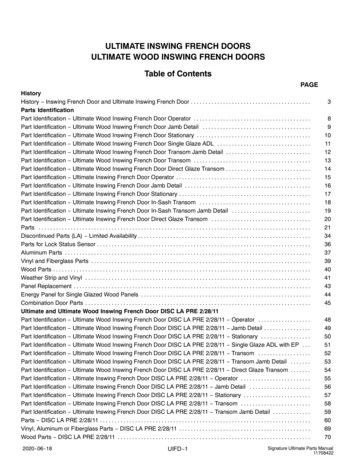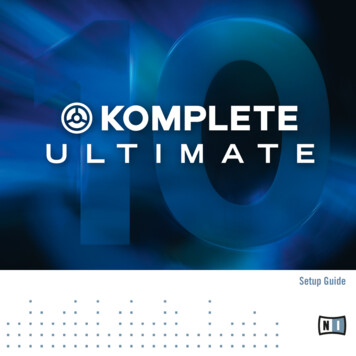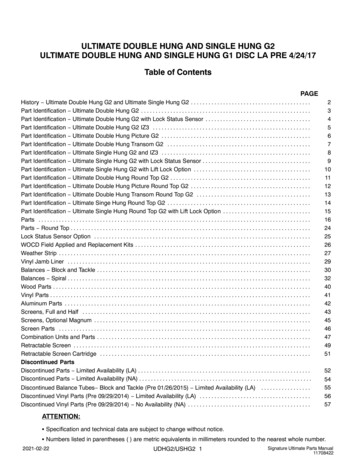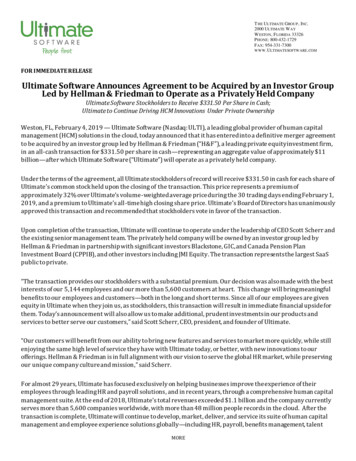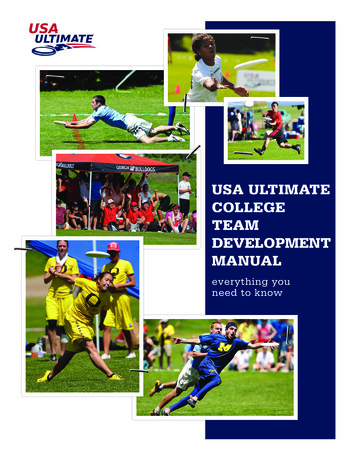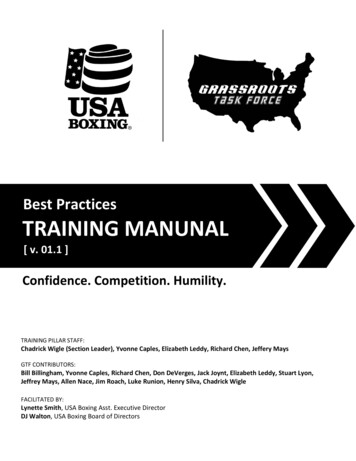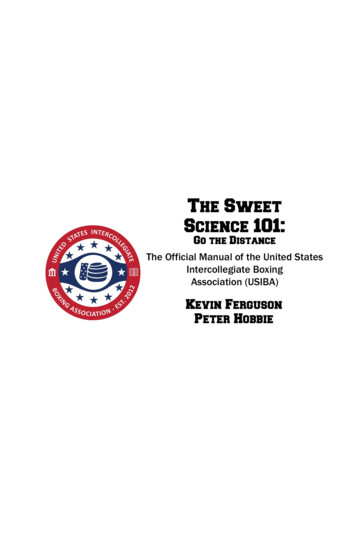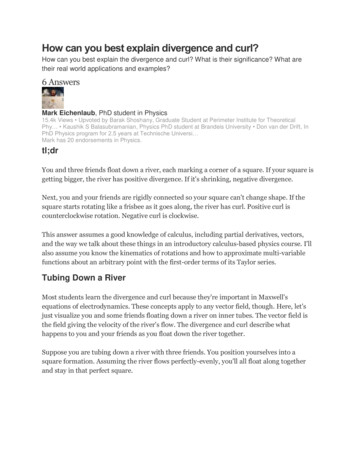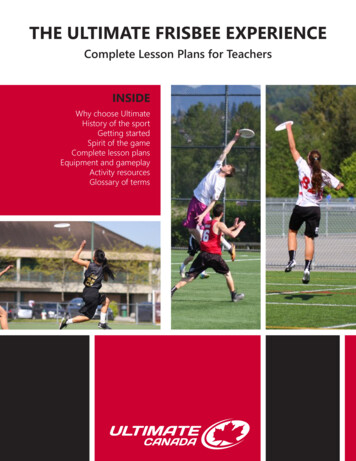
Transcription
THE ULTIMATE FRISBEE EXPERIENCEComplete Lesson Plans for TeachersINSIDEWhy choose UltimateHistory of the sportGetting startedSpirit of the gameComplete lesson plansEquipment and gameplayActivity resourcesGlossary of terms
The Ultimate Frisbee ExperienceComplete Lesson Plans For s:Grant and Carol ShawMike ChuraDeanna ChuraDanny SaundersChristiane MarceauTodd MelvilleWilliam Arlotta Ultimate Canada, June 2017 Ultimate Canada, June 20171
Table of Contents1. IntroductionWhat is Ultimate? . 4The History of Ultimate . 4Ultimate Today . 4Why Choose Ultimate? . 5What if I have never played Ultimate? . 62. What is Spirit of the Game (SOTG)? . 73. How can I use this document . 84 How to play UltimateThe Field . 9Equipment Needed . 910 Simple Rules . 10Gameplay . 115. Ultimate Lesson PlansBefore you begin . 13Beginner Level:Lesson 1Backhand Throw, Pancake Catch, SOTG Activities . 14Lesson 2Defense, Basic Rules, Modified Game, SOTG Activities . 19Lesson 3Forehand Throw, Small Sided Games,Modifying Field Size, SOTG Activities . 23Lesson 4Ultimate Game, SOTG Activity . 316. Ultimate: Next StepsLesson 5The “C” Catch, Cutting, Modified Gameplay, SOTG Activities . 34 Ultimate Canada, June 20172
Lesson 6Hammer Throw, Ultimate Game, SOTG Activity . 39Lesson 7Force Side Defense, Intermediate Backhand,Modified Game, SOTG Activities . 42Lesson 8Stack Offense, Modified Game, SOTG Activities . . 47Appendix AUltimate: Advanced Skills and Activities . 51Intermediate Forehand . 52Specialty Cuts: Receivers – Mirror CutsHandlers – Magic Cuts . 53Horizontal Offense . 56Appendix B: Activities Resources and Spirit of the Game ResourcesActivities Resources: Two Player Activities . 60Three Player Activities . 61Team Activities . 62SOTG Activities Resources: Points for Discussion . 65Be Calm. 67Spirit Games. 68Appendix C: . 70Black Line Masters: BE CALM . 71Ultimate in 10 Simple Rules . 72Glossary . 73List of Ultimate PTSO’s and organizations . 76National Coaches Certification Program . 79Appendix D: Suggested Timelines . 80 Ultimate Canada, June 20173
1. IntroductionWhat is Ultimate?Ultimate is a team sport played using a disc (Frisbee), with 7 players (one line) per teamon the field at a time.The History of UltimateIn 1967, 15-year-old Joel Silver learned how to play Frisbee football at summer camp.The sport was similar to regular football, but there was no contact and unlimited forwardpassing.Joel returned in the fall to Columbia High School in Maplewood, New Jersey, continuingto throw the disc with his fellow students. By the spring, Silver and his friends hadorganized a lunch-hour game of Frisbee football with a team from the studentnewspaper. The teams were composed of both athletes and non-athletes alike.Originally, there were 20 to 30 players on the field at one time.By 1969, games were played in the school parking lot, because it was lit, everyweekend night, and on school vacations. The number of players on the “field” wasreduced to 7 per team, due to the width of the lot.The sport was named Ultimate, as Joel considered the game to be the Ultimate sportsexperience. The players considered Ultimate to be a gentleman’s sport, so there was no needfor referees. While initially only men played the game, eventually women joined in tomake Ultimate a truly co-ed sport. Many of these original rules form the basis of therules today.Many used to consider Ultimate to be a “hippie” sport, as it evolved during the hippieera. Players would sometimes wear wild costumes, and men might even wear skirts. Ifan unusually beautiful natural event, such as a rainbow or a huge thundercloud wereobserved, the players would call a “mother nature moment”, and the game would stopwhile they marvelled at the beauty they saw.Ultimate TodayToday Ultimate is a worldwide sport recognized by the International OlympicCommittee.Each year in Canada there are provincial, high school national, and the CanadianUltimate Championships (CUC). There are summer leagues in every province and twoterritories, where players of every skill level are welcome. Some provinces have indoorleagues during the winter months. Costs to play are kept as low as possible becauseUltimate is truly a grassroots based game. And yes, in some tournaments you can stillsee wild costumes because, at it’s core, Ultimate is about the joy of play. Ultimate Canada, June 20174
Why choose Ultimate?What are the advantages for students playing Ultimate?The main reasons to choose Ultimate are inclusion, vigorous activity, low costs, personalgrowth and responsibility, and playing a lifelong sport.Ultimate is fun and easy to play. Many times, students who have not been successful attraditional team sports find Ultimate very appealing. All they have to be able to do is run,play some defense and catch a disc. Throwing skills will come later. Ultimate is also oneof few sports where boys and girls can play together on a team. Because Ultimate is anon-contact sport, the risk of serious injury is reduced. Players can easily practice theirthrowing skills. All that is required is a disc and a small outdoor, or even indoor, space.Players who advance in the sport can try out for provincial and national teams.Selection to these teams is based on skill. There are no tier systems that players mustcompete in. One teacher from a small inner city school in Winnipeg, reported that four ofhis players had played at world championships; two, while still in high school.Ultimate is a high intensity sport. Players are always running during a point. In aregulation game, players cannot substitute until a point is scored, but by modifying therules, players can switch off (similar to hockey) if they get too tired. This modified type ofgame is called Speed Ultimate, or Switch on the Fly Ultimate.The equipment costs for Ultimate are minimal. Teachers need access to a field, anumber of marker cones, and some 175 gram discs. Participants need a light and adark shirt (pinnies will also suffice), and runners. Football or soccer cleats are required ifstudents want to join local leagues outside of school.Ultimate does not rely on referees to enforce the rules. Players on the field areresponsible for calling infractions, and resolving any disputes. Being honest and treatingopponents fairly is a cornerstone for “Spirit of the Game”, which is unique to Ultimate.Ultimate is a lifelong sport. Throughout Canada there are 34,000 players in 70 leaguesregistered with the national sports organization; Ultimate Canada. There are also anestimated 70,000 players who are part of school and social clubs. Players range fromelementary school age to over 60 years old. There are leagues and divisions for playersof every skill level, from beginners to national team members. Each year in Canada,there are Provincial Ultimate Championships, National High School Championships,and National Junior Club Team Championships. Every two years, there is a WorldJunior Championship played in a different country each time.Worldwide, the World Flying Disc Federation estimates that people in over 50 countriesplay Ultimate.i Recently, the International Olympic Committee has recognized Ultimate.This means that Ultimate can compete with other sports for inclusion into future OlympicGames.ii Ultimate Canada, June 20175
“Ultimate is a game that helps develop physical literacy skills such as: spatial awareness balance and proprioception hand-eye coordination multisensory processingKids who play Ultimate are exposed to situations that regularly develop life skills suchas: learning and practicing co-operation and teamwork empathy, honesty, and self-regulation building logical thinking skills through strategy learning and practicing healthy competition” iiiWhat if I have never played Ultimate?There are many resources to support teachers who have never played Ultimate. In thisdocument you will find links to videos, and Ultimate National and Provincial/TerritorialSports Organizations (PTSO) to help you in teaching the sport. If your school has anUltimate team, there may be students available to demonstrate and teach throwingskills. One recommendation would be to contact your PSO or local Ultimate association(listed in Appendix C) and ask for assistance.What resources are available to help me coach a school team?Appendix C contains information regarding the National Coaching Certification Programwhich teaches coaches the skills needed to run an effective Ultimate program. Ultimate Canada, June 20176
2. What is Spirit of the Game?Spirit of the Game (SOTG) is what makes Ultimate unique among sports. Becausethere are no referees, players themselves are responsible for fair and honourable play.From the United States of America Ultimate (USAU) 11th Edition Rules:Spirit of the Game: Ultimate relies upon a spirit of sportsmanship that places theresponsibility for fair play on the player. Highly competitive play is encouraged, butnever at the expense of mutual respect among competitors, adherence to the agreedupon rules, or the basic joy of play. Protection of these vital elements serves toeliminate unsportsmanlike conduct from the Ultimate field. Such actions as tauntingopposing players, dangerous aggression, belligerent intimidation, intentional infractions,or other win-at-all-costs behavior are contrary to the spirit of the game and must beavoided by all players." USAU 11th Edition Rules, Rule 1.b.It is very common to see opposing players congratulating each other after anexceptional play, or a long, hard fought point. After a game, some teams will perform acheer that honours the opposing team; win or lose. At national and internationalcompetitions, teams may give a “Spirit prize” to an opposing player who hasdemonstrated excellent Spirit during the match.While all sports encourage sportsmanship, SOTG is different. Sportsmanship does notrequire a player to admit to an infraction that might place her team at risk of losing apoint or a game. SOTG demands that if a player commits an infraction and is called forit, he must acknowledge that he committed the infraction and accept the consequences,even if it puts his team at risk of losing a point or the game.Ultimate is self-officiated. Calls and disputes on the field are settled by the players onthe field. There are no outside agencies to appeal to. Thus, the integrity of the sport isembodied in SOTG and the players who adhere to it.For more information about SOTG, visit Ultimate Canada at:https://canadianultimate.com/en ca/spirit-of-the-game Ultimate Canada, June 20177
3. How can I use this document?There are three sections in this curriculum. Ultimate: Beginner Level, consists of fourlessons designed to introduce students to the game. Ultimate: Next Steps, teachesintermediate skills. Ultimate: Advanced Skills and Activities can be found inAppendix A. These lesson plans are for players who have already had exposure to thebeginning and intermediate sections.The lessons can be followed in a linear fashion, one after another, or the teacher maypick and choose which lessons to teach based on the needs of the group of students athand. If the school has an Ultimate team and players are in the class, teachers maywish to group students according to ability and then present lessons according to skilllevel. Time for activities is flexible and the teachers should decide how long to spend oneach one.If the time to teach Ultimate is limited, practicing of skills may give way to game play sothat students are active. Conversely, if there is more time available, the teacher maywish to present a specific lesson over two time slots to maximize student understandingand allow for skill development and practice during class time.Spirit of the Game (SOTG) activities should always be included in a lesson. They do nottake much time and are essential in the teaching, understanding and practicing ofSOTG. Each lesson contains SOTG questions for discussion, as well as an activity.These questions and activities are also listed in Appendix B. If teachers require morethan one class to complete a lesson, they should refer to Appendix B for additionalSOTG resources.Unlike some other sports that rely on tiering or level systems to identify elite athletes,Ultimate relies only on a player’s skills and abilities at the times of provincial or nationaltryouts. Because of the potential for players to participate in high level competition,teachers should ensure that they teach the game properly, and access outsideresources if required, so that players have a solid grounding in the game.The most important consideration when teaching Ultimate is that of “having fun”.Ultimate is a sport where laughter and fun are never in short supply. Even at high levelsof play, mistakes can be fodder for good-natured joking; but never taunting. Studentsshould be reminded that dropped discs and bad throws are part of the game and thatthe most important thing is to keep smiling and keep trying. Ultimate Canada, June 20178
4. How to Play UltimateThe FieldUltimate fields are measured in yards, the same as football fields. The diagram belowincludes metres for reference. The orange diamonds indicate cone placement.An Ultimate field is 40 yards wide, and 70 yards from goal line to goal line. Each endzone is 20 yards deep. Field size can be changed to accommodate a smaller areaplaying area, or modified game play. For example, if the class is in a gym, thebasketball court would be the field and teams would have 3 or 4 players. If using a smallspace outdoors, teams could have 5 players and the field would be 25 yards wide, 42yards long, with end zones on 14 yards. Lesson 3 has more field size options.70 yd64 m20yd18 m40 yd37 mEquipment NeededUltimate has minimal and inexpensive equipment requirements. Plastic cones are usedto mark the end lines and goal lines. Players traditionally have dark and light jerseys.Pinnies can be used in place of these. Players on interscholastic teams use football orsoccer cleats, but running shoes will suffice at the beginner classroom level.The most important piece of equipment is the disc. The official disc of Ultimate weighs175 grams. Several manufacturers make this weight of disc, the most common beingDiscraft and Daredevil. It is vital that a 175 gram disc be used. Lighter discs will not flyas well and heavier discs can be hard to throw. With that being said, younger playersmay have more success with the 145 gram Discraft J-Star disc. Contact your localultimate association (listed in Appendix C) for help in purchasing the correct discs andalso to access special discounts offered by some leagues. Ultimate Canada, June 20179
RulesThe rules of Ultimate can be somewhat complex. For beginning players, a simple tenpoint summary has been created. (See Appendix C for a printable Black Line Master ofthis resource)Ultimate in 10 Simple Rulesby Steve Courlang and Neal Dambra1.The Field: A rectangular shape with end zones at each end.A regulation field is 70 yards by 40 yards, with end zones 25 yards deep.2.Initiate Play: Each point begins with both teams lining up on the front of theirrespective end zone line. The defense throws ("pulls") the disc to the offense.A regulation game has seven players per team.3.Scoring: Each time the offense completes a pass in the defense's end zone,the offense scores a point. Play is initiated after each score.4.Movement of the Disc: The disc may be advanced in any direction bycompleting a pass to a teammate. Players may not run with the disc.The person with the disc ("thrower") has ten seconds to throw the disc.The defender guarding the thrower ("marker") counts out the stall count.5.Change of Possession: When a pass is not completed (e.g. out of bounds,drop, block, interception, stalled), the defense immediately takes possessionof the disc and becomes the offense.6.Substitutions: Players not in the game may replace players in the gameafter a score and during an injury timeout.7.Non-contact: No physical contact is allowed between players.Picks and screens are also prohibited. A foul occurs when contact is made.8.Fouls: When a player initiates contact on another player a foul occurs. When afoul disrupts possession, the play resumes as if the possession was retained.If the player committing the foul disagrees with the foul call, the play is redone.9.Self-Officiating: Players are responsible for their own foul and line calls.Players resolve their own disputes.10.Spirit of the Game: Ultimate stresses sportsmanship and fair play. Competitiveplay is encouraged, but never at the expense of respect between players,adherence to the rules, and the basic joy of play. Ultimate Canada, June 201710
GameplaySimplifiedUltimate is a non-contact sport played by two seven player teams. Each player willmatch up and guard a player on the other team. Regulation games are to 15 points.Games may have lower point totals if desired. The game starts with one team receivinga throw (like a kickoff) from the other team. The disc is passed in any direction betweenoffensive players. The thrower must establish a pivot foot before throwing and is notallowed to take any steps. The thrower must pass the disc to a receiver within 10seconds; otherwise it is a turnover. The person guarding the thrower counts out the 10seconds. If contact occurs on the thrower, it is deemed a foul and the 10 second countstarts again at 0. If contact occurs on the receiver, it is deemed a foul and the disc isreturned to the thrower. Any time a pass is incomplete, intercepted, or lands out-ofbounds, a turnover occurs, resulting in a change of possession of the disc. A point isscored when a player passes the disc to a teammate in the end zone.DetailedThe captain of each team brings a disc and meets on the sideline. They flip the discs,like a coin toss, while one captain calls “odds” or “evens”. If both discs land with thelabel side up, or both with the label side down; that is “evens”. If one disc is label sideup and other label side down; that is “odds”. If the outcome of the flip matches the call ofthe captain, then she gets to choose whether her team will start on offense or defense,or she can choose a side of the field. If the outcome does not match her call, the othercaptain gets to choose. (NOTE: All bolded words are in the glossary)Each team has seven players standing on opposite goal lines. For Co-ed play, theteams are usually comprised of four boys and three girls. Teachers are free to modifythis ratio, based on the makeup of the class. The team starting on defense throws thedisc to the other team. This is called the pull. Each defensive player will guard anoffensive player.The team on offense receives the disc and moves it up the field by passing it betweenplayers. Players get open to receive a pass by making cuts; sharp, explosive changesof direction designed to create space between themselves and their defender. Playersmust establish a pivot foot as soon as possible after they catch the disc and before theythrow it to the next player. Running with the disc is not allowed. When an offensiveplayer catches the disc he becomes the thrower. The defender guarding him becomesthe mark and starts a stall count. The defender begins with the word “stalling” and thencounts off ten seconds out loud. The defender cannot touch the disc or block thethrower’s vision. If the thrower does not pass the disc within ten seconds, or if the passis dropped, or incomplete, it is a turnover and the defensive team takes over on offense.If the pass is complete a new thrower/marker relationship begins again at “stalling one”. Ultimate Canada, June 201711
The defense can also block, knock down or catch a disc in the air. These are alsoturnovers.Ultimate is a non-contact sport, so defensive players may not contact offensive playersin any manner. Physical contact results in a foul that can be called by the offensiveplayer. There is no holding or picks and screens. (NOTE: There will likely be some mild,incidental contact. But if that contact influences the outcome of the play; it is a foul.)The disc is advanced up the field, but must always be caught in bounds. If the disc hitsthe ground, or is caught out of bounds, it is a turnover. Play re-starts with the newthrower tapping the disc on the ground, or having the new defender tap the disc, thencalling, “Disc in”. When any one of the players on the offensive team catches a disc inthe opposition’s end zone, a point is scored. The team that scored stays in that endzone. The other team walks back to the opposite end zone, resulting in a change ofdirection after every point.Sometimes there are disputes on the field. For example: Did the marker really foul the thrower? Did the defender foul the receiver? Was the catch in bounds? Was ten seconds reached before the pass?Whenever a call is made, the player that call is directed to can “contest” that call. If hedoes not, then the call stands and play continues. As part of SOTG, the players on thefield deal with all contests. Sideline players and coaches are not allowed to becomeinvolved in the dispute resolution process, unless players on the field ask for a ruleclarification, or help with perspective. If, after 30 seconds, a resolution cannot bereached then the disc is returned to the last thrower to have possession. Play resumeswith the disc being “checked in” by the mark. This ensures that the defense is ready toplay. In Ultimate, it is acceptable to “agree to disagree”. Players should refrain fromloud, heated arguments, and focus on resolving the issue quickly and calmly.Otherwise; “Back to Thrower”!Player substitutions can only be made between completed points, except in the case ofinjury. If there is an injury on the field, play immediately stops. If an injured player onTeam A is replaced, then Team B has the right to replace any one of their playerswithout giving a reason. This offsets the advantage that Team A will get by having arested player come into the game.In regulation play, games are to 15 points, with a 10 minute half-time when one teamhas scored 8 points. Teachers may want to modify this to assist new players. Smallerfields and lower point totals are completely acceptable. The best thing a teacher can dois modify the games so that students can score points. When you are a beginner, thereis nothing more exciting than scoring a point in Ultimate! Ultimate Canada, June 201712
5. Ultimate: Lesson PlansBefore You BeginIdeas for Dealing with Players who have Ultimate ExperiencePlayers with Ultimate experience could be asked to assist in demonstrating the skillspresented in each lesson. They can also work with beginning players as mentors to helpwith skill acquisition. At the teacher’s discretion, they may be released from the maingroup and allowed to work on throwing and catching skills on their own, or play any ofthe small sided games listed in Lesson 3 or do the activities in Appendix B.If there are two teachers in the class, one teacher can stay with each group after thesplit. If the teacher with the experienced group is comfortable, and the group desires,lessons 5, 6, or 7 may be presented. Alternatively, the teacher may simply supervise thesmall sided game.(NOTE: Most importantly, the experienced players should be active and enjoying theclass, without feeling held back by the beginning players.)Teaching TipIn order to minimize distraction, have players place all discs on the ground while you areteaching a skill or concept.Avoid instructing too much, unless it is in a discussion where the students are engagedin the conversation. Focus on the main points, potentially only two or three per skill orstrategy, that you want them to internalize. The most fun they will have is when they areon the field, throwing, catching and running.The Most Important Part of Ultimate: Spirit of the Game (SOTG)Be sure to include SOTG activities at the end of each class. While playing Ultimate isfun, celebrating SOTG makes it even better! The SOTG Point for Discussion shouldallow players to reflect and comment on their attitudes towards self-officiating, fair playand spirit in general. Always strive to keep the conversations positive and nonjudgemental. The additional Spirit Game may be omitted it time is short. The SOTGPoint for Discussion should always be included.Each Spirit Game activity is a suggestion only. Teachers should feel free to substituteother games.The important thing is that the players’ experience includes a sense of community, lifeskill development and, of course, fun! Ultimate Canada, June 201713
Lesson 1 – Beginner Level: Backhand Throw, Pancake Catchand SOTG ActivitiesSpecific Learning Outcomes! To throw a backhand with proper technique! To catch a disc using the Pancake catch technique! To develop a sense of timing when throwing and catching a disc! To introduce Spirit of the GamePre-Lesson: Teachers may wish to give a brief overview of the game of Ultimate.The videos below show highlights of high school level Ultimate om/watch?v RCWgV2XPIX0flightringsBasic Backhand ThrowNOTE: For a video tutorial about the backhand throw, link to:https://www.youtube.com/watch?v 8oBzItB3220The basic backhand is the easiest throw to learn. The three important elements are:Grip, Stance, Throw (GST)1. Grip: How to hold the disc Place your thumb on top of the disc, along the flight rings (the concentric circleridges near the edge of the disc)Wrap your other fingers under the edge of the disc Ultimate Canada, June 201714
2. Stance: How to position the body If you throw right-handed, step acrossyour body with your right foot. If youthrow left-handed, step across yourbody with your left foot. This allows youto extend your body further to throwaround a defender. Think of doing alunge.Your back foot is your pivot foot. Makesure it stays on the ground to avoidtravelling. Pivot on this foot and stepacross, until your body position isperpendicular to your target (thereceiver).The shoulder of your throwing arm should face your target.Hold the disc parallel to the ground.3. Throw: Releasing the disc Swing your throwing arm forward, keeping the disc parallel to the ground.As you release the disc, flick your wrist. This gives the disc spin. Spin makes thedisc fly straighter and further.Upon release, your hand should be pointing at your target.NOTE: If your throw is wobbly, or headed in the wrong direction, you are trying to throwusing only your elbow and shoulder, instead of flicking your wrist.With practice, steps 2 and 3 are done in one quick fluid motion, to avoid having yourdefender block your throw.HINT: If students are having trouble mastering the wrist flick, have them pair up andstand facing each other about 2 yards apart. Have them throw the disc to one anotherby only flicking the wrist, keeping the elbow and shoulder stationary.Tell them that throwing a disc is like snapping a towel. Ultimate Canada, June 201715
Activity (Indoors or Outdoors): In groups of two, about 10 yards apart, have theplayers practice the backhand throw. (Modification: If you do not have sufficient discs,place students in groups of 3 or even 4.)Cues for ThrowingA. If the disc is not thrown straight Be sure your grip is firm enough to hold the disc flat. Make sure the disc is flat, parallel to the ground. Make sure your throwing hand is pointing towards the target upon release.B. If the disc fli
and National Junior Club Team Championships. Every two years, there is a World Junior Championship played in a different country each time. Worldwide, the World Flying Disc Federation estimates that people in over 50 countries play Ultimate.i Recently, the International Olympic Committee has recognized Ultimate.



